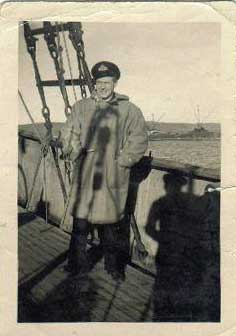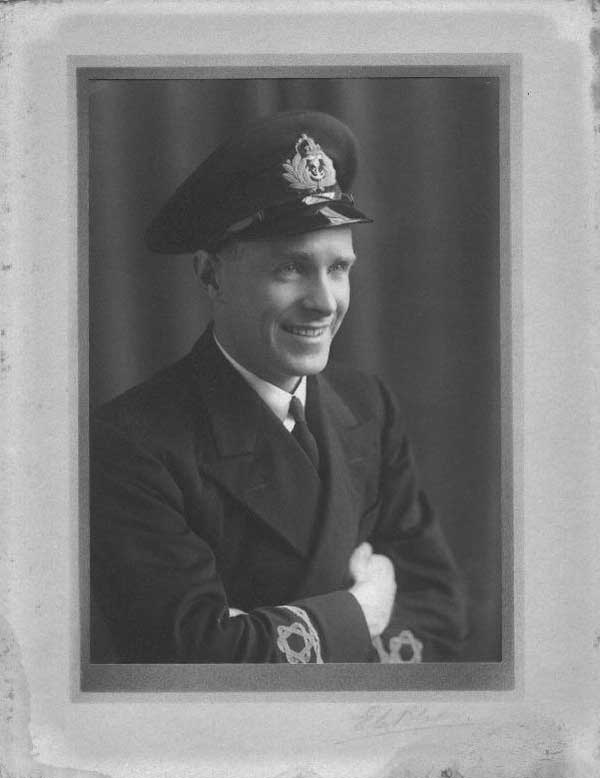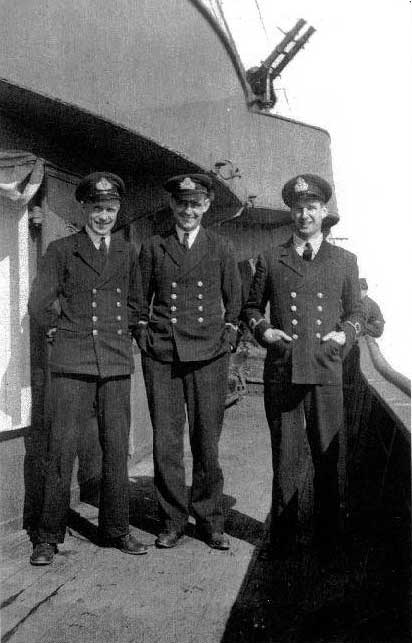|
An interview with Captain F.A.J. Downer, CO of the Northern Spray with Convoy ONS 5
BRITISH INDIA A Master and his Ship Capt. F.A.J. Downer, D.S.C.,R.D., R.N.R. (Retd.) and the ‘Nevasa’ By The Editor, Sea Breezes November 1969 A SHIP which has become well-known to many schoolchildren throughout the United Kingdom is the British India liner Nevasa (20,746 gross tons) which for the past four years has been engaged in the company's highly successful programme of educational cruises. These days the Nevasa is a busy ship, with only a minimum of time in port, but during September I was able to take advantage of one of her slightly longer calls at Liverpool—2½ days in between cruises—to call on board as she lay at Princes Landing Stage to meet her master, Capt. F. A. J. Downer, D.S.C., R.D., R.N.R. (retd.). In his comfortable suite just abaft the bridge, I chatted to Capt. Downer about his career at sea, which, apart from naval service during the Second World War, has been spent entirely with the British India Steam Navigation Co. Ltd. His boyhood home was at Lee-on-Solent, where ships of all types, both naval and merchant, were always in sight, and notwithstanding an original desire to enter the Royal Air Force, it was to the merchant navy that he ultimately turned.
So it was that in 1929 the future Capt. Downer applied to the British India Company, and joined his first ship in London docks as a cadet. She was the steamer Australia (7,531 gross tons), a former German ship built in 1912, taken as a First World War prize, and acquired by British India from the Shipping Controller in 1915. The Australia was the B.I. cadet ship, and Cadet Downer spent about 3½ years in her, trading to Australia, often from Liverpool on the Federal and New Zealand Shipping Companies' berth. He ended his time in her as a P.O. cadet, and then transferred to a somewhat larger ship, the Matiana (9,045 gross tons) in a similar capacity. His first promotion to the officer grades came in 1934 when he was appointed fourth officer in the Durenda (7,241 gross tons), a comparatively early motorship, dating from 1922. Six months later he moved to the Barala; then followed a period of service in various ships of the fleet, including vessels on the fast mail service between the Persian Gulf and Bombay, and the passenger liner Kenya (9,890 gross tons), built in 1930. During this stage of his career he was away from home for four years. Promotion came again in 1938, when he became third officer in the Matiana; by this time he was also a member of the Royal Naval Reserve, and as the clouds of war became more threatening, it seemed increasingly likely that he would be called upon for naval service. September 1939 brought the outbreak of the Second World War and Capt. Downer laid aside his British India uniform for that of the Royal Navy. His service was mainly in corvettes and frigates, first taking part in anti-submarine patrols off Norway in the Narvik area, and then in the Western Approaches, based at Liverpool and Birkenhead.
Later he was based at St. John's, Newfoundland, where he was seconded to the Royal Canadian Navy and given command of the corvette H.M.C.S. Chilliwack. In 1942 he returned to Britain and took command of H.M. trawler Northern Spray at Birkenhead, once more on Western Approaches patrols, and completed his seagoing naval service in H.M.S. Montserrat, a frigate of the "Colony" class. See "The Battle For Convoy ONS 5. 26th.April - 6th. May 1943." When the war ended Comdr. Downer found himself at Barrow-in-Furness, standing by a new naval vessel under construction by Vickers-Armstrongs, Ltd., but before she was completed, he was demobilised. Although he had considered remaining with the Royal Navy, he had finally made up his mind to return to British India, and by February 1946 was at sea with his old company again, albeit well down the scale, as second officer in the Mantola (9,065 gross tons).
Some years as second officer in various ships on the Eastern service followed, until in 1950 he was promoted to chief officer in the motorship Chantala (7,551 gross tons), a new vessel built that year, which became the second of the company's post-war cadet training ships. Once again service in a variety of the company's ships as chief officer followed, until, in 1955, Capt. Downer received his first command. This was a somewhat unusual appointment—to the company's steam tug Arusha (346 gross tons), based at Mombasa. Built in 1951 by Henry Robb, Ltd., at Leith, her task was to tow barges and lighters up and down the East African coast, serving the smaller ports and loading points which were inaccessible to larger vessels. Today the Arusha is well-known in the port of Falmouth as the St. Mawes, the largest tug in the fleet of the Falmouth Towage Co., Ltd. Capt. Downer held command of her on the East African coast, where she was also available for salvage duties, for 12 months. In 1956 he went home on leave, and was then appointed chief officer in the motorship Chilka (7,132 gross tons), subsequently moving to the Waroonga (8,750 gross tons) in the same capacity, and trading on the Australian service. A complete change for Capt. Downer came in 1959. By that time the B.I. company had diversified into the tanker trade, and he was appointed super-numary in the turbine tanker Queda, of some 19,000 tons deadweight, built in 1958, in order to gain tanker experience. Later the same year he spent a month at the Shell refinery at Stanlow, on the Manchester Ship Canal, continuing to gain experience of oil traffic. In 1960 Capt. Downer was given command of the turbine tanker Quiloa, another 19,000-tonner, and remained in her for some 12 months, before moving in 1961 to the command of the cadet training ship Chindwara. But once again change was around the corner, for while on leave at the end of 1963, he was instructed to join the educational cruise ship Devonia as a passenger to gain experience of this form of cruising. Looking back, Capt. Downer admitted that he had some misgivings at the time, but in the light of subsequent experience, he has no regrets whatever about joining the educational cruise ships. In 1964 he became relieving master of the Devonia and Dunera, and in January 1965 was appointed to the command of the Dunera, moving to the Devonia in the September. Then in August 1966, he was transferred to the command of the Nevasa, where he has remained to the present time. Capt. Downer now lives at Fareham, Hants. Having served in almost every type of ship from tug to passenger liner, he finds his present task in command of the Nevasa a rewarding and satisfying one, giving many hundreds of students, both boys and girls, their first seagoing experience. Nevasa
Built: 1956 Barcley Curle and Co. Ltd., Glasgow. Yard No. 733
A fine-looking ship, the Nevasa, third of the name in the history of the British India fleet, was completed in 1956 by Barclay, Curie and Co., Ltd., Glasgow. Designed as one of Britain's largest troopships, for charter to the Ministry of Transport, she is a twin-screw turbine-driven ship, but her career as a trooper lasted a mere six years. The Government's decision to abandon trooping by sea in favour of air transport made her redundant, and after making her last trooping voyage in 1962 she was laid-up in the River Fal. For two years she lay there, near the King Harry Ferry, and then at last, the decision to convert her to an educational cruise ship having been taken, she was moved from her lay up berth to the shipyard of Silley, Cox and Co., Ltd., Falmouth, who had been awarded the conversion contract. The move took place on St. Andrew's Day, 1964, and strangely enough, it was Capt. Downer who was appointed to the temporary command of the vessel to make the move. The Nevasa was a dead ship, bad weather was forecast, and Capt. Downer called for all six tugs of the Falmouth Towage Co., Ltd., including his former command, the St. Mawes (ex-Arusha) to manoeuvre the ship from the buoys and round the tricky bend in the Fal to the open waters of Carrick Roads and so to the shipyard in Falmouth harbour. Fortunately the approaching depression, with its accompanying gale force winds, held off long enough for the operation to be safely completed, and the conversion work soon got under way. Sea trials were carried out from September 15-18, 1965, and the completed ship finally left Falmouth on October 17 on a shakedown cruise with a large party of guests. The Nevasa made her maiden cruise as a school ship from Southampton, sailing on October 28, 1965 for Madeira, Tangier and Lisbon. Since then she has maintained a full programme of cruises each year. The ship carries 307 adult passengers in cabin accommodation (which may include 70-odd teachers) and 1,090 students in dormitories, the latter having from 12 to 42 berths. Schools and education authorities from all over the country have taken part in cruises in the Nevasa. There is a permanent education staff on board who arrange lectures in the assembly hall, classroom periods, organised deck games, visits to the bridge and engine room and many other activities. British India educational cruises have proved their worth, and the Nevasa is an ideal ship for the job—modern, large, but not too large, and stabilised for smooth sailing. Her itineraries are varied and sailings are made from most of the major ports of Britain during the year. Capt. Downer and his ship's company have every reason to find their job a rewarding one.
|



